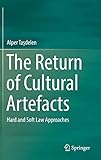Return of Cultural Artefacts : Hard And Soft Law Approaches
Publication details: Springer Switzerland 2016Description: xiii, 227 pISBN:- 9783319440590
- 341 TAS.R
| Item type | Current library | Call number | Status | Date due | Barcode |
|---|---|---|---|---|---|
 Books
Books
|
Symbiosis Law School, Noida | 341 TAS.R (Browse shelf(Opens below)) | Available | SLSN-B-13444 |
Browsing Symbiosis Law School, Noida shelves Close shelf browser (Hides shelf browser)
Contents
Machine generated contents note: 1.Introduction: Cultural Property vs. Cultural Heritage
References
2.The Classical Approach: International Treaties
-Part 1
2.1.First Steps
2.2.The 1970 UNESCO Convention on the Means of Prohibiting and Preventing the Illicit Import, Export and Transfer of Ownership of Cultural Property
2.2.1.Overview
2.2.2.The Historical Developments Leading to the Adoption of the 1970 UNESCO Convention
2.2.3.The Purpose of the 1970 UNESCO Convention
2.2.4.The 1970 UNESCO Convention's Scope of Application
2.2.5.The 1970 UNESCO Convention's Rules on Return
2.2.6.The 1970 UNESCO Convention's Regulations Combating Illicit Trafficking and Supporting Return
2.2.7.The Institutional Framework of the 1970 UNESCO Convention: The Meeting of State Parties
2.2.8.Evaluation
3.The Classical Approach: International Treaties
-Part II
3.1.The 1995 UNIDROIT Convention on Stolen or Illegally Exported Cultural Objects
Contents note continued: 3.1.1.Introduction
3.1.2.From UNESCO's Request to the Adoption of the 1995 UNIDROIT Convention
3.1.3.The 1995 UNIDROIT Convention's Goals
3.1.4.The Ambit of the 1995 UNIDROIT Convention
3.1.5.The 1995 UNIDROIT Convention's Regulations on Restitution and Return
3.1.6.The Complementary Rules of the 1995 UNIDROIT Convention Promoting Restitution and Return
3.1.7.Assessment
3.2.The Classical Approach: Synopsis
4.The Two-Pronged Strategy: Transiting to a Cooperative and Procedural Solution
4.1.The Need for New Approaches
4.2.The Institutional Approach: UNESCO's Intergovernmental Committee for Promoting the Return of Cultural Property to Its Countries of Origin or Its Restitution in Case of Illicit Appropriation
4.2.1.General View
4.2.2.From the 1970 UNESCO Convention to the Establishment of the ICPRCP
4.2.3.The ICPRCP's Purpose
4.2.4.The Field of Operation of the ICPRCP
Contents note continued: 4.2.5.The ICPRCP's Institutional Framework
4.2.6.The Modus Operandi of the ICPRCP
4.2.7.The ICPRCP's Work and Its Achievements
4.2.8.Summary
4.3.The Soft Law Approach: Bringing Private Parties on Board
4.3.1.Soft Law: Prelude
4.3.2.The ICOM Code of Ethics for Museums
4.3.3.The UNESCO International Code of Ethics for Dealers in Cultural Property
4.3.4.The ILA Principles for Cooperation in the Mutual Protection and Transfer of Cultural Material
4.4.The Two-Pronged Strategy: Resume
5.The Alternative Dispute Resolution Approach: Formalisation and Juridification of the Dispute Resolution Procedure
5.1.Alternative Dispute Resolution: Assessment
5.2.The ICPRCP Rules of Procedure for Mediation and Conciliation
5.2.1.Overview
5.2.2.The Issuing of the ICPRCP Rules of Procedure for Mediation and Conciliation
5.2.3.The Application Field of the ICPRCP Rules of Procedure
Contents note continued: 5.2.4.The ICPRCP Rules of Procedure's Definitions of "Mediation" and "Conciliation"
5.2.5.The Constitution of the ICPRCP Rules of Procedure's Mediation and Conciliation Bodies
5.2.6.The Mediation and Conciliation Procedure of the ICPRCP Rules of Procedure
5.2.7.Synopsis
5.3.The ICOM-WIPO Mediation Rules
5.3.1.General Remarks
5.3.2.The Path Leading to the Adoption of the ICOM-WIPO Mediation Rules
5.3.3.The Field of Operation of the ICOM-WIPO Mediation Rules
5.3.4.The ICOM-WIPO Mediation Rules' Notion of "Mediation"
5.3.5.The ICOM-WIPO Mediation Rules' Appointment Procedure for the Mediator
5.3.6.The Mediation Procedure of the ICOM-WIPO Mediation Rules
5.3.7.Final Remarks
5.4.Alternative Dispute Resolution: Summary
6.Conclusion.









There are no comments on this title.